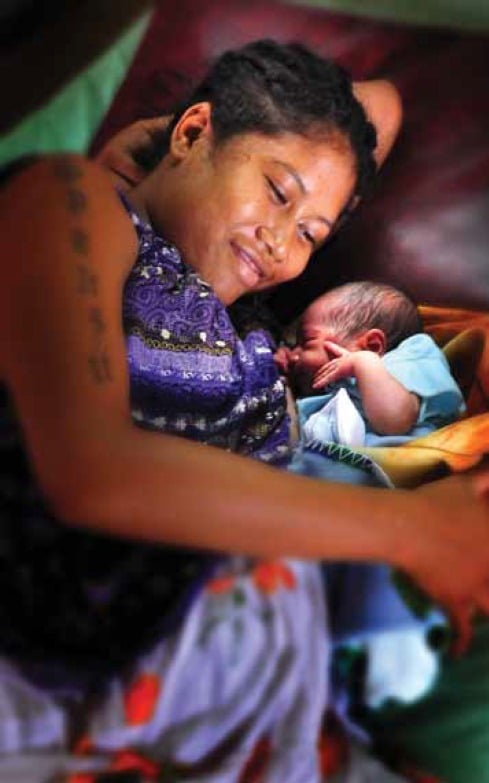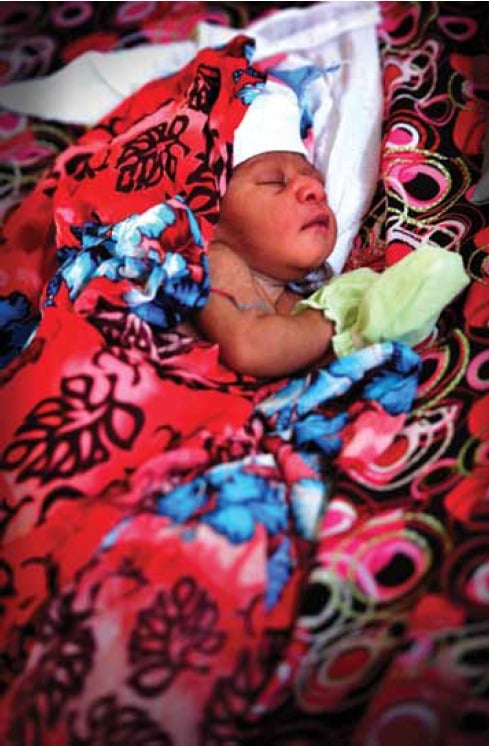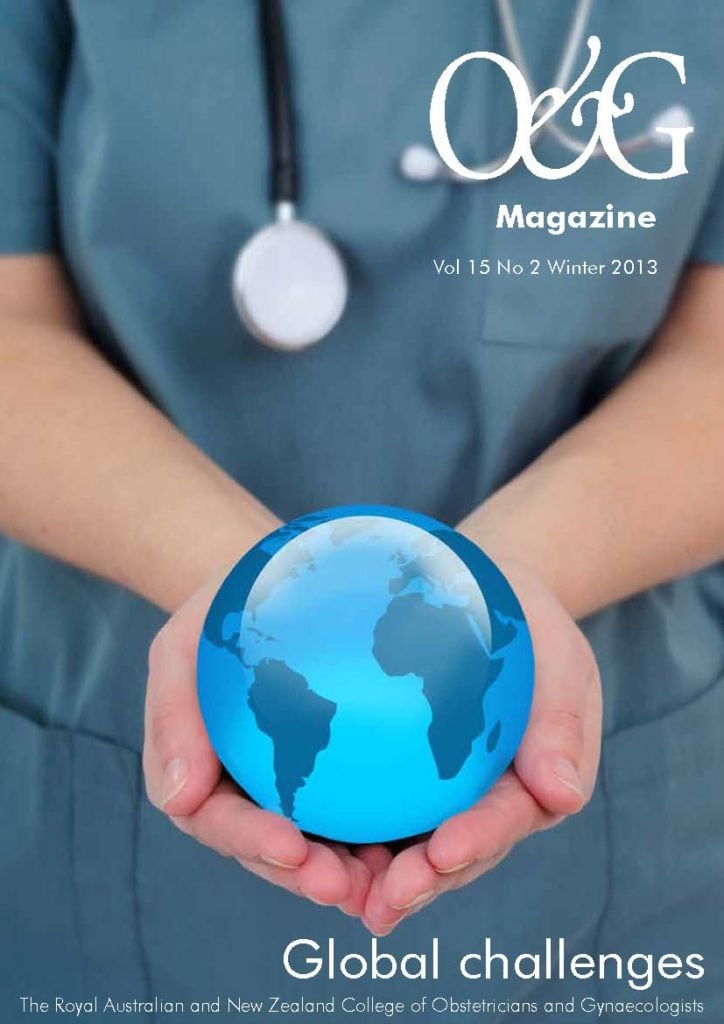How the Millennium Development Goals herald another failure for global women’s health.
Maine and Rosenfield, writing in 1999, said: ‘A deep, dark continuous stream of mortality…[for] how long is this sacrifice to go on?’ William Farr, the first registrar general of England and Wales, asked this question about maternal mortality in England in 1838; a century and a half later, we still have not answered it.1
Over three cool and clear September days in 2000, exactly one year before the World Trade Center attacks, the United Nations complex in New York hosted the ‘Millennium Summit.’ The meeting played host to the largest gathering of world leaders to date, and the specific agenda was to define the role of the United Nations in the new century. The General Assembly resolution leading to the summit had attempted to grasp ‘a unique and symbolically compelling moment to articulate and affirm an animating vision for the United Nations.’ Over the three days, the 189 member states ratified the United Nations Millennium Declaration, agreeing to assist people in the developing world to attain a better life by the year 2015. To provide a framework for mapping progress, the leaders focused on clearly-defined issues that were summarised as the Millennium Development Goals (MDGs).
In the wake of the summit, all of the 193 member states of the United Nations, as well as two dozen large international organisations agreed to achieve the goals in the stated timeframe, now only two years away. The goals are listed in Table 1. Of special interest to us is MDG number five (see Table 2). The goal is very specific and two-fold: reduce the maternal mortality ratio by three quarters, and achieve universal access to reproductive health. Unfortunately, things are not looking good for the achievement of the maternal health MDG. Lack of progress towards achievement of MDG 5 became apparent in September 2010, a decade after the goals were agreed to, when the United Nations Secretary-General launched the Global Strategy for Women’s and Children’s Health. This renewed strategy called for an additional US$40 billion from developed countries and NGOs ‘in response to slow progress and the moral urgency of reinvigorating efforts to tackle child and maternal mortality.’2
Table 1. The Millennium Development Goals
| 1. | Eradicate extreme poverty and hunger. |
| Target 5a | Reduce maternal mortality by three-quarters between 1990 and 2015: |
| 5.1 | Reduce the MMR* |
| 5.2 | Increase the number of births attended by skilled health personnel |
| Target 5b | Achieve universal access to reproductive health by 2015: |
| 5.3 | Increase the contraceptive prevalence rate |
| 5.4 | Reduce the adolescent birth rate |
| 5.5 | Increase antenatal care coverage |
| 5.6 | Reduce unmet need for family planning |
The scope of the problem
The World Health Organisation (WHO) estimates published in 2007 suggested that more than 500 000 women died each year from complications of pregnancy and childbirth.3 The report also emphasised that many more women survived such complications, but were permanently affected, suffering lifelong ill health and disability. However, the effects were highly disparate between different countries, and even within countries. Indeed, it was noted that, ‘the difference in maternal mortality rates between developing and developed countries show[ed] the greatest disparity of all health indicators.’3 The vast majority, about 90 per cent, of all global maternal deaths were found to occur in South Asia and the sub-Saharan region of Africa.
There had been previous attempts to deal with the appalling rates of maternal death in these regions. The Safe Motherhood Initiative was initiated at a major international conference in Nairobi back in 1987. The conference led to a subsequent series of national and regional ‘Safe Motherhood’ meetings, designed to raise awareness among those responsible for public health policy.1 The FIGO meeting the following year devoted plenary sessions on maternal mortality in developing countries, and a ‘program of collaboration between obstetrics societies in developed and developing countries was begun.’1 One of the stated aims of the Safe Motherhood Initiative was to reduce maternal mortality by half by the year 2000. Yet at the start of the new millennium, when the MDGs were developed, maternal mortality remained unchanged from 1985.
Table 2. Indicators for progress with MDG 5
| Target 5a | Reduce maternal mortality by three-quarters between 1990 and 2015: |
| 5.1 | Reduce the MMR* |
| 5.2 | Increase the number of births attended by skilled health personnel |
| Target 5b | Achieve universal access to reproductive health by 2015: |
| 5.3 | Increase the contraceptive prevalence rate |
| 5.4 | Reduce the adolescent birth rate |
| 5.5 | Increase antenatal care coverage |
| 5.6 | Reduce unmet need for family planning |
*MMR – Maternal Mortality Ratio.
How can this happen? Maine and Rosenfield1 drew the following conclusion:
In our view, an important reason for the lack of progress in reducing maternal mortality is the absence of a clear strategic focus in the Safe Motherhood Initiative. One of the keys to the success of the Child Survival Initiative was that it gave governments and international agencies a short list of actions required to prevent deaths among young children from the most common causes.
In contrast, the Safe Motherhood Initiative [was] much broader. According to WHO, the initiative encompasses family planning, antenatal care, clean/safe delivery, essential obstetric care, basic maternity care, primary health care, and equity for women. While all of these are clearly worthy and important goals, in fact only one, essential obstetric care, includes actions that can substantially reduce maternal deaths.
Show us the numbers
To determine whether strategies to reduce maternal death actually work, it is important to obtain data. This may sound simple, but it is not. In developed countries such as Australia and New Zealand, civil registration of maternal death is in place. Civil registration systems mean that there is scrupulous ascertainment of the numbers of maternal deaths, and usually a national confidential inquiry system, to determine the causal factors for such deaths. These systems were discussed in detail in the previous issue of O&G Magazine. Such civil registration data is almost always non-existent in resource-poor countries.3
For this reason, information about rates of maternal death in developing countries are invariably presented as estimates based on a number of methodologies household surveys, ‘sister-hood’ methods, reproductive age mortality studies (RAMOS) and population censuses.3 In countries where many women deliver away from health facilities or where births are not officially registered, mortality data can be extremely difficult to estimate. This leads to extremely wide confidence intervals around such estimates. For example, the estimated rate of maternal mortality for South East Asia is 240 per 100 000 with a possible range between 160 and 350.3 With such discrepant estimates, it can be almost impossible to tell whether risk-reduction strategies are having any effect at all.
Unsurprisingly, different bodies publish different estimates of the MMR and rates of improvement. As van den Broen and Falconer3 point out:
What is going wrong?
MDG 5 is the worst performing of all the goals. Despite all efforts, a number of countries are not only showing no improvement, but their MMR is actually getting worse.2 Estimates published in the Lancet in 20112 reveal that, ‘although there is acceleration in many countries, only nine of 137 developing countries are likely to achieve both the MDG 4 and MDG 5 targets by 2015.’ Why should this be, with an additional US$40 billion allocated to the problem as recently as 2010? Lozano and colleagues2 see the reason as follows:
In reality, part of the problem is that nobody actually knows what works. When a systematic review was conducted to summarise the evidence of the impact and effectiveness on MDG 5 outcomes of official development aid, the authors concluded that they could find few meaningful data and that there were ‘major gaps in the evidence base that should be used to inform new approaches and methodologies aimed at measuring the impact of official development aid.’4 In other words, the evidence of effectiveness for the aid strategies being funded was scanty. This leaves the world in the situation of not knowing the size of the problem, not knowing how accurately to measure whether the help is actually working and not knowing what works anyway.

A healthy mother and a healthy baby: the best outcome for the family and the community.

Empowering women is a driver of long-term change.
Despite the bad news, the Australian Government seems upbeat about achieving the MDGs. The AusAID website (www.ausaid.gov.au) contains the following statement:
Australia’s Parliamentary Secretary for Climate Change, Mark Dreyfus, made the following remarks at a UN Symposium for Development in May of 2012:
The Director General of AusAID, Peter Baxter, was more realistic when addressing the Lowy Institute in back in 2010:
[Our] region […] contains about two thirds of the world’s poor, many of whom live in China and India. In contrast with China and India with their huge populations and substantial growth potential, the Asia Pacific region is also home to many small island developing states such as Tuvalu and Kiribati. These small island states face enormous challenges in making faster progress towards the MDGs due to their lack of human and physical resources and their remote geographic locations. But of course relying on statistics based on China and India would hide the unevenness of progress between countries in the Asia Pacific and within many countries themselves. Even national statistics hide the reality that while some groups have made good progress others have not.
Questions we need to look at are why some countries such as Vietnam have made relatively strong progress while others such as the Philippines have not. Why are Vanuatu and Samoa making stronger progress towards the MDGs than their Pacific neighbours?
Is MDG 5 a failure?
Australians Tim Sullivan and Jane Hirst reviewed the progress towards achievement of MDG 5 in 2011, four years from the deadline of 2015.5 They concluded that the targets were very unlikely to be achieved, but were optimistic: ‘The achievements of isolated countries suggest that success is not unattainable.’

A supervised birth is a safer birth – for mother and baby.
Similarly, in the editorial of a special supplement in BJOG dealing with progress towards MDG 5, the comment was made that results are: ‘difficult to achieve despite the continued efforts of some incredibly committed healthcare professionals to improve outcomes for mothers and children.’6 The editors went on to write that:
Others are not so impressed. Prof David Grimes, who spoke so passionately at the RANZCOG Annual Scientific Meeting in Auckland, is convinced that misogyny is at the heart of disadvantage for women in many parts of the world. Speaking at the ACOG Annual Clinical Meeting in 2011, he said:
Every day, misogyny kills women around the globe in two ways: directly through violence and indirectly through apathy.
Women are dying needlessly because societies just don’t value them. Examples […] range from lack of equal treatment, to emotional and physical abuse, to murder. Maltreatment of women has been institutionalized by governments and religions for millennia.
Approximately 343 000 women worldwide die each year from complications of pregnancy and childbirth, an average of one death every other minute…Nearly all of these deaths are preventable. [Certain] societies have yet to make the decision that these women’s lives are worth saving.
It is obvious that many and varied reasons account for the extraordinary difficulties encountered in trying to save the lives of women. Vast amounts of money do not seem to be helping. In the end, it seems that little has changed since Maine and Rosenfeld analysed the reasons for failure of the Safe Motherhood Initiative back in 1999:
References
- Lozano R, Wang H, Foreman K, et al. Progress towards Millennium Development Goals 4 and 5 on maternal and child mortality: an updated systematic analysis. Lancet 2011; 378: 1139-1165.
- Van den Broek NR, Falconer AD. Maternal mortality and Millennium Development Goal 5. Br Med Bull 2011; 99: 25-38.
- Maine D, Rosenfield A. The Safe Motherhood Initiative: Why Has It Stalled? Am J Pub Health 1999; 89: 480-482.
- Taylor EM, Hayman R, Crawford F, et al. The impact of official development aid on maternal and reproductive health outcomes: a systematic review. PLoS One 2013: 8: e56271.
- Sullivan TR, Hirst JE. Reducing maternal mortality: a review of progress and evidence-based strategies to achieve Millennium Development Goal 5. Health Care Women Internat 2011; 32: 901-916.
- Van den Broek NR, Roberts D. Editorial, Millennium Development Goals supplement, BJOG 2011.







Leave a Reply